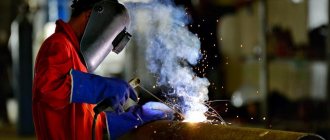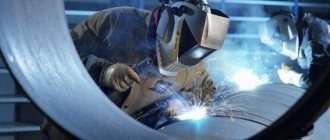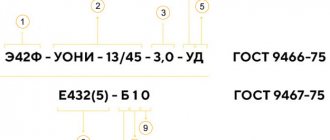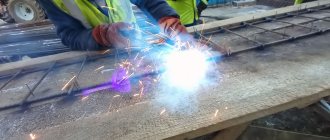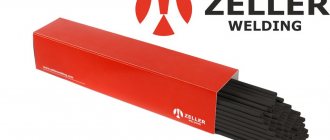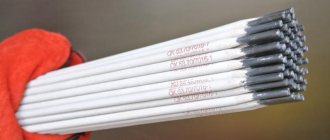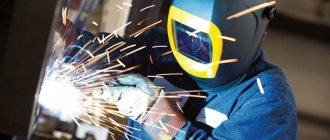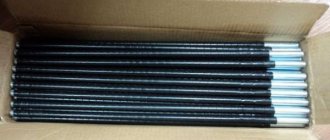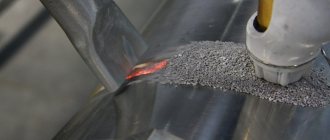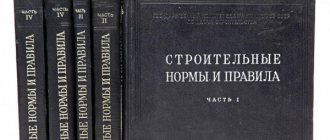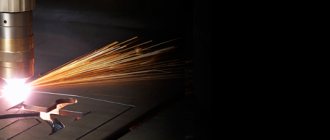Home / Electrodes
Back
Reading time: 3 min
0
2104
In his professional activity, any welder will sooner or later encounter thin sheet metal. This can be any metal sheet with a thickness of up to 2 mm.
It is found quite often, for example, profiled pipes are made from it.
Work of this type is not the most difficult of welding works, it does not require high power of the apparatus and large-diameter electrodes, however, there are nuances that must be taken into account, otherwise the weld will not be of high quality.
In this article we will talk about the intricacies of working with thin sheet metals.
- Welding Features
- Types of arc welding
- Electrodes for welding
- Preparation for welding
- Inverters
- Welding technique
- Working with galvanized steel
- Finally
Welding Features
The main trouble that you may encounter with this type of welding is that a thin metal sheet can burn out when heated.
When heated for a long time, holes may form in it, so you need to cook quickly. Set the current strength to small, it is better to use a short arc.
The inconvenience is that such an arc can go out when separated from the surface, so welding should be done using devices with high current-voltage data.
Also, high temperature can cause wave-like deformation of the sheet, so try not to overheat it.
As we have already said, such welding must be done using a short arc. When choosing electrode rods for welding, you must take into account the type of metal being welded and its thickness.
For example, to weld a sheet with a thickness of 1 -1.5 mm, we take electrode rods with a diameter of 2 mm.
You should try to cook quickly and continuously, without lifting the electrode from the metal, and at the same time, avoiding overheating of the sheet and burning it. The recommended current for such work is 40-60 A.
Advantages of thin electrodes
- This is the only consumable that can be used for arc welding of thin products without the great risk of burning out the workpiece;
- Electrodes for welding thin metal with an inverter have a relatively low cost, so you can always buy a large amount of material;
- In terms of their physical properties and composition, they are almost as good as the thicker representatives of the brand;
- The electrodes are quickly prepared, since drying and calcination takes a relatively short amount of time.
Types of arc welding
We have already described the first option; this is continuous welding, in which the electrode is welded at a constant speed. However, this method is more suitable for experienced welders, since choosing the right speed is not so easy.
If you cook too quickly, the seam will not be cooked along the entire length; if you cook too slowly, the sheet will overheat, become deformed, or a hole will form.
Therefore, the following method is more popular, in which the electrode is periodically removed from the surface. The third method is pointwise.
With this method, cook using light touches. With each of these methods, it is imperative to monitor the temperature in the welding zone and avoid overheating the metal.
Main types of electrodes
This welding equipment is divided into main classes, depending on the type of metal used:
- For welding heat-resistant alloy steel;
- For high alloy steel;
- For structural steel (for arc welding);
- For metal surfacing;
- For non-ferrous metals;
- For cast iron;
- For thin metal (the thinnest are less than 2 mm in diameter).
Types of electrodes by type of coating
The letter designations indicate the type of electrode coating:
- A – acid coating, containing silicon, manganese, iron;
- B – main coating, which includes calcium fluoride and calcium carbonate. Suitable for welding with direct current of alternating polarity;
- C – cellulose coating with an organic base;
- R – rutile coating. Additionally contains organic substances and minerals.
Types of electrodes by welding position
Choosing the position of the current conductor is a serious aspect of the welding process. There are several valid position options:
- Any provisions;
- Any position other than vertical from top to bottom;
- Bottom (vertical from top to bottom and horizontal);
- Bottom position.
Types of electrodes for operation with direct current
This type of welding is the easiest, safest and most reliable, ensuring an even seam. In this case, special electrodes are used that are suitable specifically for conducting direct current:
- MR-3S. Has blue markings. It is used for welding carbon and low-alloy steel, provides a high-quality and even seam, and facilitates the process.
- OZS-4. Electrodes with red markings. Suitable for welding carbon and low-alloy steels, as well as oxidized surfaces.
- OZS-12. These are red electrodes intended for critical structures (made of low-carbon steel). Welding in all positions except vertical is acceptable.
- SSSI 13/45. Products with a basic coating for welding vessels under pressure, metals of great thickness, as well as for the process of welding possible defects. Suitable for low alloy and carbon steel.
- SSSI 13/55. For working with pressure vessels, building metal structures (from low-alloy and carbon steels).
Types of electrodes for welding on cast iron
Since cast iron is one of the most common materials, it is worth considering separately the types of electrodes used for welding products made from this material. It should be noted that direct current electrodes are used to melt cast iron.
- MNC-2. Allows welding in the lower, vertical and semi-ceiling positions with direct current of reverse polarity.
- OZCH-2. For malleable and gray cast iron in the lower and vertical position, with direct current of reverse polarity.
- MNC-4. For cast iron of any type in vertical and downward positions (direct current of reverse polarity).
- TsCh-4. Used only in the lower position for cold and hot welding. Allows the fusion of cast iron with another type of steel. At high voltage the current becomes alternating.
- OZCH-4. For working with any type of cast iron, in the upper and lower positions, exclusively with direct current of reverse polarity.
- OZZHN-1. Electrode for cold welding of ductile and gray cast iron in the lower and vertical position.
- OK 92.18. For welding when heated (with direct and alternating current).
Electrodes for welding
The choice of electrode rods depends on the characteristics and properties of the metal being welded, such as thickness, melting point.
It is important that the melting temperature of the material being welded is close to the melting temperature of the electrode rod. Above we present you with several tables that will help you choose the right electrode.
If we need to weld low-alloy or carbon steels, then electrodes of the MTG-01K, MTG-03 brands will help us. They can also be labeled as LEZ-MR.
They are undemanding in terms of metal cleanliness and can weld dirty, oxidized, and wet surfaces.
Most often they are used for installation work, for example, welding pipe joints. But do not forget - the result when welding unprepared material will always be worse.
We set the current value based on the thickness of the sheet. The relationship here is direct - the thicker the sheet we cook, the higher the current strength we must set in order to melt it.
Below you can see how the current strength and diameter of the electrode rod depend on the thickness of the sheet being welded.
Which electrodes are best for cooking: choosing the right electrodes
A welding electrode is a relatively small rod that is made from various metals and has electrically conductive properties. Its main purpose is to supply current during welding. The quality of the seam depends largely on the chosen electrode. Considering that there are quite a large number of varieties, the question arises: “which electrodes are best for solving a particular problem?”
Key selection criteria
When choosing which electrode to weld metal with, you need to consider the following parameters:
- Rod diameter.
Selected depending on the thickness of the structure being welded. The thinnest rods have a diameter of 1.6 mm. They are intended for joining sheets no thicker than 2 mm, while rods with a diameter of 5-6 mm allow you to weld sheets up to 13 mm thick.
- Welding current strength.
This parameter is calculated in such a way that for each millimeter of the rod there is about 30-40 Amperes of current. If welding is performed in a vertical position, the current strength is reduced by 15%. - Metal grade.
Each of them has its own unique chemical composition and physical properties. For example, to work with heat-resistant steels, you need to use electrodes that provide a temperature of about 1100°C.
Please note that the welding current should not be too low, as this will cause the tip to stick. If the values are excessively high, the arc will burn well, but in this way the surface of the material can be burned. In this mode, rods with a small diameter burn out very quickly, unable to cope with their task.
It is also important what components the rod coating consists of. As a rule, there are 6-12 of them. In this case, each component is responsible for creating the environment necessary for the formation of strong seams with stable characteristics.
The main ones:
- cellulose layer - creates a cloud of gas with a reducing agent;
- calcium fluoride – makes iron oxides more fusible, and the released gas stabilizes the combustion process;
- carbonates - responsible for the formation of slags;
- ferromaterials (Mg and Si) – deoxidize the seam after welding;
- titanium dioxide - allows the slag to harden, which improves the fluidity of the melt;
- gum with clay elements - makes the coating more durable;
- iron powder – improves the quality of the weld by equalizing the temperature.
It is necessary that the material of the electrodes and the type of metals being welded match their characteristics.
Welding carbon and low alloy steels
In this case, the main role is played by the electrode coating material. So, for welding boiling grades of steel (has a low carbon content and is slightly deoxidized), any coating is suitable. To weld semi-quiet steels, which have large sheet thicknesses, a base or rutile coating is required. When welding structures made of mild steel at low temperatures or under dynamic loads, electrodes with a basic coating are also used.
Unstable arc combustion can deteriorate the quality of the seam and will not allow normal welding of metal structures using alternating current. The arc burns best in the presence of cellulose, acid and rutile coatings. In this case, you can use welding transformers. In addition, you need to thoroughly clean the welded edges from rust, oil and dirt in order to avoid the formation of steam.
How to weld and surfacing cast iron
The procedure allows you to eliminate defects in cast iron castings, as well as restore damaged parts that have exhausted their service life. The result is steel, various alloys based on copper, nickel, etc. Models of the TsCh-4, OZCH-2, OZCH-6 and similar brands cope best with the above task. In some cases, for example, during the repair of cast iron tubes with heavy contamination and high humidity, it is advisable to use the OZL-25B, OZL-27 and OZL-28 grades.
Welding of non-ferrous metals
Each of these metals has its own melting threshold and physical and chemical properties. For example, intense oxidation does not allow welding of titanium and its alloys. In the case of aluminum, the process is complicated by the oxide film, which melts at a temperature of 2060°C, and in order to melt the aluminum itself, 660°C is enough. The film formed due to the oxide can lead to disruption of the integrity of the seams and a decrease in their strength. It is removed by adding chloride and fluoride salts of alkali and alkaline earth metals.
Copper also has its own problems when welding - pores form in the weld under the influence of gas bubbles (especially oxygen and hydrogen). To avoid this, the copper must be well deoxidized, and the edges must be thoroughly cleaned before welding begins. In turn, bronze is highly brittle, and nickel and its alloys are sensitive to gases dissolved in the weld pool - nitrogen, oxygen and hydrogen. As a result of this process, hot cracks and pores appear in the metal structure.
Metal cutting
Arc cutting of metal structures is used for installation and repair of various metal structures. It is not very efficient; you should not expect a “beautiful” seam from it, or an accurate cut.
However, this cutting method does not require additional equipment or highly qualified workers. It is easy to learn for a beginner. Cutting by electric arc welding is often used in training, in particular in mastering the principles of working with an inverter. This method is often used by home craftsmen for inexpensive metal cutting.
Welding alloy steels with increased heat resistance
Alloyed heat-resistant steels are welded with special electrodes that provide a certain heat resistance of the welded joints.
The resulting structure must withstand significant mechanical loads and high temperatures. The likelihood of cracks forming due to temperature changes is also minimized. Thus, at temperatures up to 475°C, models made of molybdenum like E-09M are used, and at temperatures up to 540°C, models with a high content of chromium and molybdenum (E-09MH, E-09X1M, E-09X2M1 and E-05X2M) are used. . E-10Kh5MF has a high chromium content, which makes it possible to weld steel structures with the appropriate chemical composition.
What electrodes should be used to cook high-alloy steel?
Such steels contain 13% chromium and have anti-corrosion properties. In this case, the metal seam must be resistant to atmospheric precipitation in slightly aggressive environments, heat-resistant (maximum temperature 650°C) and heat-resistant (maximum temperature 550°C).
Models of type E-12Х13 of brands LMZ-1, ANV-1, etc. have such properties. If the steel has a low carbon content and there is nickel alloying, preference is better to give to products under the index E-06Х13Н. If you need to weld steel sheets containing 25% chromium, options like E-08X24N6TAFM are best, making the finished weld ductile, impact-resistant and corrosion-resistant.
Welding of dissimilar steels and alloys
We are talking about steels and alloys that have unique physical and mechanical properties, chemical composition, and weldability. Such steels can be carbon and alloyed, high-strength, heat-resistant, and also high-alloy.
Welding steels and alloys with dissimilar structures also has a number of characteristic features. To avoid the formation of cracks, areas with an inhomogeneous structure at the melting site, as well as excessive growth of residual stresses, models like ANZHR-1, OZL-27, NIAT-5, EA-395/9, OZL-25B, IMET-10 and TsT- are used 28 with special properties.
Welding machine compatibility
When choosing which electrodes to weld steel with, it is necessary to take into account not only the type of material for which they are intended, but also the features of the welding machine.
Of course, in theory and in practice, the owner of an electric arc machine can use any electrode. However, in reality there are devices that are better suited for use with rods of a certain type of coating (for example, IN226 CEL - excellent for cellulose-coated electrodes).
In addition, welding machines have a current limitation. This range imposes its own limits on the use of diameter electrodes. How to determine if consumables are suitable? Just look at the table below:
Now you are more familiar with electric arc welding and some of the nuances of choosing welding electrodes. We advise you to read other articles in this section to gain useful knowledge about welding processes, materials and important nuances for improving the quality of welding work.
Preparation for welding
The surface of thin-walled metal must be pre-treated to a shine using sandpaper or a grinding machine.
To obtain the best result, surfaces must be degreased with a solvent. The better we prepare the surface, the better the quality of the seam we will get.
After cleaning, place the sheets on a flat surface, avoiding gaps between them, and fix them in this position.
For this purpose, clamps of all types are used. Then use small seams every 10 cm to connect the parts.
This will prevent thin-walled surfaces from shifting or bending. The final welding can now be carried out.
Characteristics and selection criteria
One of the main parameters of welding electrodes is its coating, or rather its composition:
- Rutile coated conductors. This also includes conductors with mixed rutile-based coating. These are the most popular electrodes, characterized by ease of ignition. Used with alternating and direct current in any position.
- With basic coating. Typically used for DC welding. They provide a plastic seam, but are characterized by difficult ignition and increased sensitivity to humidity.
- With a sour coating. Like products with rutile coating, they are used for inverters, however, work in this case must be done in a well-ventilated area.
- For beginners, electrodes of the OZS-12 type are suitable, while UOSI are more related to professional work.
- Manual arc welding involves the use of a welding inverter. The components for this device must be dry and undamaged. They are selected according to the type of inverter, regarding the technical characteristics of this device.
- The weight of one electrode for each individual brand is different, depending on the materials used. The weight of electrodes in a pack according to the standard should be 3 kg, 5 kg and 8 kg for electrodes with a diameter of 2.5 mm, 3-4 mm, 4 mm, respectively.
Inverters
Inverter-type machines are best suited for welding thin sheet metals. A properly configured inverter will help you achieve good results.
The advantage of such devices is that we can work by setting them to reverse polarity. In this case, the electrode heats up more, and the metal is weaker, which reduces the risk of burning it.
For high-quality inverter welding, it is recommended to use electrode rods with a diameter of 1.5 - 2 mm, with a sufficient melting coefficient.
The current must be set to 30-45 A for 1.5 mm and 40-60 A for 2 mm. To reduce the heating of the surfaces to be welded, they must be installed vertically, at an angle of 30-40 degrees, and welded from top to bottom.
Best Cellulose Coated Welding Electrodes
A feature of such rods is the presence of a large number of organic elements in the composition.
When using electrodes with cellulose coating, a high speed of work is achieved, easy separation of slag, and gas protection of the material is created.
They are used for welding main pipelines, processing carbon and low-alloy steels.
ESAB Pipeweld 6010 Plus
4.9
★★★★★
editorial assessment
94%
buyers recommend this product
The main advantages of these rods include ease of control of the welding arc and a large penetration depth. The quality of the seam does not depend on the chosen spatial position, so working with rods is extremely convenient.
The line of electrodes is represented by samples of various diameters: 2.5, 3.2, 4 and 5 mm. This allows you to successfully process metal with a thickness of more than 10 millimeters. The rods do not require calcination before starting work.
Advantages:
- stable combustion;
- easy slag separation;
- smooth seam;
- economical consumption.
Flaws:
- don't like dampness.
ESAB Pipeweld 6010 Plus are suitable for domestic or professional use. A wide range of permissible diameters allows processing metals of various thicknesses.
Craton J422
4.9
★★★★★
editorial assessment
91%
buyers recommend this product
The electrodes are distinguished by the high quality of the welding seam produced. They have a low tendency to form pores and cracks, as well as high strength - 420 MPa. A high-quality coating is not subject to shedding even when deformed.
Rods of various diameters are available to the buyer, including 2.5, 3.2 and 4 mm. This allows you to process metal with a thickness of 2 to 6 millimeters. Work can be carried out in any spatial position and under different temperature conditions.
Advantages:
- ease of slag separation;
- low metal losses;
- high-quality seam;
- low price.
Flaws:
- difficulty of secondary ignition.
Kraton J422 are used for welding low alloy steels. Electrodes will be especially useful when processing root seams of pipelines or when used in hard-to-reach places.
Welding technique
For each individual case, a different welding technique is used; you choose it yourself, guided by your experience. Here are some methods.
Sorting. With this method, the edges of the sheet are bent and the metal is fastened with transverse seams at intervals of 5-10 cm. Then we weld the parts in a continuous movement from top to bottom.
This method requires sufficient experience; when applying a continuous seam, burning of the sheet is possible.
To avoid this, it is recommended to tear off the arc for a short time, allowing the part to cool, then lower it, moving it a few millimeters. The main thing is that the metal does not have time to cool down too much.
Butt welding. This is a rather complex method; it is easier to overlap weld. However, if you decide to weld using this method, a wire placed between the sheets to be welded can make the task easier.
The welding arc must be guided along the wire; it will take the entire temperature load on itself, and the sheets will not overheat. A replacement for wire can be copper plates.
They must be placed under the surfaces to be welded. Copper has high thermal conductivity, heating up faster than the metal, it will not allow it to overheat.
Features of the technology
To avoid burning the metal, you need to draw an electric arc along the joint as quickly as possible. The consumable must be carried evenly, without stopping in any place. The operating current for performing such operations is reduced to a minimum, below which the operation is simply impossible.
To weld thin sheets of metal, you need a welding machine with continuously adjustable output current. To get rid of possible problems with ignition of the welding arc, devices with an open circuit voltage of at least 70V are used. When welding sheet materials, you should carefully monitor the geometry of the edges. It can become deformed when exposed to high temperatures. To prevent this, you should follow a few simple rules.
First of all, it is important to carefully prepare the workpieces for the upcoming operation. The edges are cleaned and freed from rust, paint, industrial fats and other things. If required, the workpieces are aligned and secured. A good and durable connection can only be obtained if the edges of the workpieces being welded are smooth and clean. Upon completion of the preparatory work, the edges are tacked every 7-10 cm. And only after this can one begin to form a continuous seam.
If you plan to weld two thin sheets overlapping, then you can set a slightly higher current than with a butt joint. Double sheets of blanks significantly reduce the negative impact of high temperature on the surface of the blanks. The probability of burning through the surface is reduced several times, and deformation is practically not observed.
Experienced welders advise resorting to a little trick when welding thin metal with an electrode. The effect of high temperature can be minimized by placing copper sheets under the workpieces. Non-ferrous metal has excellent thermal conductivity and effectively removes excess heat from the work area. This reduces the likelihood of sheet deformation or metal burning. If there is no copper sheet, then you can use wire, which is laid at the welding site.
Working with galvanized steel
Welding thin-walled galvanized steel, or galvanized steel as it is called, causes welding difficulties. What is galvanized steel? Ordinary steel, as a rule, is sheet, with a zinc coating, which creates difficulties during welding.
The zinc coating does not allow making a high-quality seam, so it must first be removed from the edges.
This is done using sandpaper, a grinder, an angle grinder, or a metal brush.
An important condition for such work is that cleaning must be done outdoors or in a well-ventilated room. During stripping, zinc can evaporate and its fumes are toxic.
Fulfillment of all the listed conditions - the correct selection of equipment and components, an optimally configured machine, a successful choice of welding method, compliance with the rules of safe welding - all this will help you achieve the desired result.
Best Acid Coated Welding Electrodes
Such rods contain oxides of iron, silicon, and manganese. They are used for welding non-critical structures or low-alloy steels with both direct and alternating current.
The resulting seams are not prone to porosity, but may be susceptible to hot cracking.
Tigarbo ANO-24
4.8
★★★★★
editorial assessment
90%
buyers recommend this product
They are distinguished by ease of arc ignition and stable combustion. Before work, it is necessary to carry out a calcination procedure at temperatures up to 180 ° C for an hour. This will allow achieving maximum efficiency in the use of rods for welding carbon steels of all degrees of deoxidation.
The electrode diameter is 4 mm, the permissible welding current is 200 A. This is enough to process metal up to 8 mm thick.
The maximum moisture content in the rod coating before use should not exceed 0.7%, so they require special storage and transportation conditions.
Advantages:
- low splashing;
- high-quality seam;
- arc stability;
- economical consumption.
Flaws:
- afraid of dampness.
Tigarbo ANO-24 is used for welding carbon steel parts of small and medium thickness. An excellent solution for occasional household chores.
Fubag 38821
4.8
★★★★★
editorial assessment
88%
buyers recommend this product
The electrode is made of carbon and can be used not only for welding, but also for surface cutting or removing excess metal from the surface. The rod has a large diameter (10 mm), allowing it to work successfully with various metals.
The length of the new electrodes is 30 centimeters, they do not melt during use and are designed to operate on direct current.
Burnout of the mass of the substance occurs extremely slowly, and the elements do not stick to the surface during welding.
Advantages:
- wide range of applications;
- efficiency;
- large diameter;
- low price.
Flaws:
- arc instability.
Fubag 38821 are used for processing non-ferrous metals, steel, heavy and light alloys. They will be useful in a car service center, service station or in a metalworking workshop.
Elitech MP-3S
4.7
★★★★★
editorial assessment
84%
buyers recommend this product
See review▶
With these electrodes you can weld in all spatial positions using both direct and alternating current. The ease of starting and re-igniting the arc makes it easy to work with intermittent seams.
The diameter of the rod is 3 mm, the length is 35 centimeters. The maximum permissible welding current of 140 A allows it to be used in everyday household work or when processing thin sheet metal.
Advantages:
- ease of use;
- ease of re-ignition;
- stable arc burning;
- economical consumption.
Flaws:
- difficult separation of slag.
Elitech MP-3C electrodes are excellent for household use. They will be effective when laying a pipeline or minor car repairs.
READ ALSO
13 best masks for welders
What polarity should the welding inverter be set?
To avoid burning through thin metal when welding with an inverter, it is recommended to use reverse polarity. Why should reverse polarity inverter be used?
There are two polarities of welding inverters: forward and reverse. It is good to boil thick metals with direct polarity, and thin metals with reverse polarity.
Everything is connected with the temperature of the arc: on direct polarity the temperature is higher than on reverse polarity. In order to cook with an inverter at reverse polarity, the electrode holder is connected to the plus of the device, and the ground cable is connected to the minus (standard connection: + to +, and - to -).
